Disposable Electrochemical Serotonin Biosensor Based on the Nanocomposite of Carbon Nanotubes
Abstract
1. Introduction
2. Materials and Methods
2.1. Chemicals and Reagents
2.2. Preparation of PAAc-PVI@MWCNTs
2.2.1. PAAc-PVI(4:1) Polymer Synthesis
2.2.2. PAAc-PVI@MWCNT Composite Preparation
2.3. Fabrication of PAAc-PVI@MWCNTs/SPCEs
2.4. Equipments for Characterizization
2.5. Biosensing Application
3. Results
3.1. Chemical Properties of PAAc-PVI
3.2. Physicochemical and Morphological Characterization of PAAc-PVI@MWCNTs
3.3. Electrochemical Characterization of PAAc-PVI@MWCNTs/SPCEs
3.4. Serotonin Sensing
3.4.1. Electrochemical Characterization Changing Electrode Conditions
3.4.2. Interfering Test
3.4.3. Serotonin Quantification
3.5. Serotonin Sensing in Serum Sample
4. Discussion and Conclusions
Author Contributions
Funding
Institutional Review Board Statement
Informed Consent Statement
Data Availability Statement
Acknowledgments
Conflicts of Interest
References
- Thomsen, S.F. Atopic Dermatitis: Natural History, Diagnosis, and Treatment. ISRN Allergy 2014, 2014, 354250. [Google Scholar] [CrossRef] [PubMed]
- Han, L.; Dong, X. Itch Mechanisms and Circuits. Annu. Rev. Biophys. 2014, 43, 331–355. [Google Scholar] [CrossRef] [PubMed]
- Schonmann, Y.; Mansfield, K.E.; Hayes, J.F.; Abuabara, K.; Roberts, A.; Smeeth, L.; Langan, S.M. Atopic Eczema in Adulthood and Risk of Depression and Anxiety: A Population-Based Cohort Study. J. Allergy Clin. Immunol. Pract. 2020, 8, 248–257.e16. [Google Scholar] [CrossRef]
- Wang, J.; Zhou, Y.; Zhang, H.; Hu, L.; Liu, J.; Wang, L.; Wang, T.; Zhang, H.; Cong, L.; Wang, Q. Pathogenesis of Allergic Diseases and Implications for Therapeutic Interventions. Signal Transduct. Target. Ther. 2023, 8, 138. [Google Scholar] [CrossRef]
- Lee, J.H.; Son, S.W.; Cho, S.H. A Comprehensive Review of the Treatment of Atopic Eczema. Allergy Asthma Immunol. Res. 2016, 8, 181. [Google Scholar] [CrossRef] [PubMed]
- Morita, T.; McClain, S.P.; Batia, L.M.; Pellegrino, M.; Wilson, S.R.; Kienzler, M.A.; Lyman, K.; Olsen, A.S.B.; Wong, J.F.; Stucky, C.L.; et al. HTR7 Mediates Serotonergic Acute and Chronic Itch. Neuron 2015, 87, 124–138. [Google Scholar] [CrossRef]
- Dorszewska, J.; Florczak-Wyspianska, J.; Kowalska, M.; Stanski, M.; Kowalewska, A.; Kozubski, W.; Dorszewska, J.; Florczak-Wyspianska, J.; Kowalska, M.; Stanski, M.; et al. Serotonin in Neurological Diseases. In Serotonin—A Chemical Messenger Between All Types of Living Cells; IntechOpen: London, UK, 2017; ISBN 978-953-51-3362-9. [Google Scholar]
- Chavan, S.G.; Rathod, P.R.; Koyappayil, A.; Hwang, S.; Lee, M.-H. Recent Advances of Electrochemical and Optical Point-of-Care Biosensors for Detecting Neurotransmitter Serotonin Biomarkers. Biosens. Bioelectron. 2025, 267, 116743. [Google Scholar] [CrossRef]
- Khoshnevisan, K.; Honarvarfard, E.; Torabi, F.; Maleki, H.; Baharifar, H.; Faridbod, F.; Larijani, B.; Khorramizadeh, M.R. Electrochemical Detection of Serotonin: A New Approach. Clin. Chim. Acta 2020, 501, 112–119. [Google Scholar] [CrossRef]
- Chapin, A.A.; Rajasekaran, P.R.; Quan, D.N.; Hu, L.; Herberholz, J.; Bentley, W.E.; Ghodssi, R. Electrochemical Measurement of Serotonin by Au-CNT Electrodes Fabricated on Microporous Cell Culture Membranes. Microsyst. Nanoeng 2020, 6, 90. [Google Scholar] [CrossRef]
- Kundys-Siedlecka, M.; Bączyńska, E.; Jönsson-Niedziółka, M. Electrochemical Detection of Dopamine and Serotonin in the Presence of Interferences in a Rotating Droplet System. Anal. Chem. 2019, 91, 10908–10913. [Google Scholar] [CrossRef]
- Robinson, D.L.; Hermans, A.; Seipel, A.T.; Wightman, R.M. Monitoring Rapid Chemical Communication in the Brain. Chem. Rev. 2008, 108, 2554–2584. [Google Scholar] [CrossRef] [PubMed]
- Boix, J.; Cauli, O. Alteration of Serotonin System by Polychlorinated Biphenyls Exposure. Neurochem. Int. 2012, 60, 809–816. [Google Scholar] [CrossRef] [PubMed]
- Zhou, J.; Sheng, M.; Jiang, X.; Wu, G.; Gao, F. Simultaneous Determination of Dopamine, Serotonin and Ascorbic Acid at a Glassy Carbon Electrode Modified with Carbon-Spheres. Sensors 2013, 13, 14029–14040. [Google Scholar] [CrossRef] [PubMed]
- Malik, M.; Narwal, V.; Pundir, C.S. Ascorbic Acid Biosensing Methods: A Review. Process Biochem. 2022, 118, 11–23. [Google Scholar] [CrossRef]
- Jain, B.P.; Goswami, S.K.; Pandey, S. Chapter 9—Clinical Biochemistry. In Protocols in Biochemistry and Clinical Biochemistry; Jain, B.P., Goswami, S.K., Pandey, S., Eds.; Academic Press: Cambridge, MA, USA, 2021; pp. 101–118. ISBN 978-0-12-822007-8. [Google Scholar]
- Sharma, S.; Singh, N.; Tomar, V.; Chandra, R. A Review on Electrochemical Detection of Serotonin Based on Surface Modified Electrodes. Biosens. Bioelectron. 2018, 107, 76–93. [Google Scholar] [CrossRef]
- Goyal, R.N.; Gupta, V.K.; Oyama, M.; Bachheti, N. Gold Nanoparticles Modified Indium Tin Oxide Electrode for the Simultaneous Determination of Dopamine and Serotonin: Application in Pharmaceutical Formulations and Biological Fluids. Talanta 2007, 72, 976–983. [Google Scholar] [CrossRef]
- Babaei, A.; Babazadeh, M. A Selective Simultaneous Determination of Levodopa and Serotonin Using a Glassy Carbon Electrode Modified with Multiwalled Carbon Nanotube/Chitosan Composite. Electroanalysis 2011, 23, 1726–1735. [Google Scholar] [CrossRef]
- Goff, A.L.; Moggia, F.; Debou, N.; Jegou, P.; Artero, V.; Fontecave, M.; Jousselme, B.; Palacin, S. Facile and Tunable Functionalization of Carbon Nanotube Electrodes with Ferrocene by Covalent Coupling and π-Stacking Interactions and Their Relevance to Glucose Bio-Sensing. J. Electroanal. Chem. 2010, 641, 57–63. [Google Scholar] [CrossRef]
- Liu, Y.; Wang, X.; Wang, W.; Li, B.; Wu, P.; Ren, M.; Cheng, Z.; Chen, T.; Liu, X. One-Step Preparation of Oxygen/Fluorine Dual Functional MWCNTs with Good Water Dispersibility by the Initiation of Fluorine Gas. ACS Appl. Mater. Interfaces 2016, 8, 7991–7999. [Google Scholar] [CrossRef]
- Suri, A.; Chakraborty, A.K.; Coleman, K.S. A Facile, Solvent-Free, Noncovalent, and Nondisruptive Route To Functionalize Single-Wall Carbon Nanotubes Using Tertiary Phosphines. Chem. Mater. 2008, 20, 1705–1709. [Google Scholar] [CrossRef]
- Peng, H.; Alemany, L.B.; Margrave, J.L.; Khabashesku, V.N. Sidewall Carboxylic Acid Functionalization of Single-Walled Carbon Nanotubes. J. Am. Chem. Soc. 2003, 125, 15174–15182. [Google Scholar] [CrossRef] [PubMed]
- Khan, A.; Alamry, K.A. Surface Modified Carbon Nanotubes: An Introduction. In Surface Modified Carbon Nanotubes Volume 1: Fundamentals, Synthesis and Recent Trends; ACS Symposium Series; American Chemical Society: Washington, DC, USA, 2022; Volume 1424, pp. 1–25. ISBN 978-0-8412-9749-4. [Google Scholar]
- Gautam, V.; Singh, K.P.; Yadav, V.L. Polyaniline/Multiwall Carbon Nanotubes/Starch Nanocomposite Material and Hemoglobin Modified Carbon Paste Electrode for Hydrogen Peroxide and Glucose Biosensing. Int. J. Biol. Macromol. 2018, 111, 1124–1132. [Google Scholar] [CrossRef] [PubMed]
- Avilés, F.; Cauich-Rodríguez, J.V.; Toro-Estay, P.; Yazdani-Pedram, M.; Aguilar-Bolados, H. Improving Carbon Nanotube/Polymer Interactions in Nanocomposites. In Carbon Nanotube-Reinforced Polymers; Elsevier: Amsterdam, The Netherlands, 2018; pp. 83–115. ISBN 978-0-323-48221-9. [Google Scholar]
- Millán-Pacheco, C.; Serratos, I.N.; del Rosario Sánchez González, S.; Galano, A. Newly Designed Melatonin Analogues with Potential Neuroprotective Effects. Theor. Chem. Acc. 2022, 141, 49. [Google Scholar] [CrossRef]
- Pratuangdejkul, J.; Nosoongnoen, W.; Guérin, G.-A.; Loric, S.; Conti, M.; Launay, J.-M.; Manivet, P. Conformational Dependence of Serotonin Theoretical pKa Prediction. Chem. Phys. Lett. 2006, 420, 538–544. [Google Scholar] [CrossRef]
- Laviron, E. General Expression of the Linear Potential Sweep Voltammogram in the Case of Diffusionless Electrochemical Systems. J. Electroanal. Chem. Interfacial Electrochem. 1979, 101, 19–28. [Google Scholar] [CrossRef]
- Coyle, V.E.; Brothers, M.C.; McDonald, S.; Kim, S.S. Superlative and Selective Sensing of Serotonin in Undiluted Human Serum Using Novel Polystyrene Sulfonate Conductive Polymer. ACS Omega 2024, 9, 16800–16809. [Google Scholar] [CrossRef]
- Jeon, W.-Y.; Choi, Y.-B.; Kim, H.-H. Ultrasonic Synthesis and Characterization of Poly(Acrylamide)-Co-Poly(Vinylimidazole)@MWCNTs Composite for Use as an Electrochemical Material. Ultrason. Sonochem. 2018, 43, 73–79. [Google Scholar] [CrossRef]
- Ding, H.; Zhang, X.N.; Zheng, S.Y.; Song, Y.; Wu, Z.L.; Zheng, Q. Hydrogen Bond Reinforced Poly(1-Vinylimidazole-Co-Acrylic Acid) Hydrogels with High Toughness, Fast Self-Recovery, and Dual pH-Responsiveness. Polymer 2017, 131, 95–103. [Google Scholar] [CrossRef]
- Drolet, D.P.; Manuta, D.M.; Lees, A.J.; Katnani, A.D.; Coyle, G.J. FT-IR and XPS Study of Copper(II) Complexes of Imidazole and Benzimidazole. Inorganica Chim. Acta 1988, 146, 173–180. [Google Scholar] [CrossRef]
- Szybowicz, M.; Nowicka, A.B.; Dychalska, A. Characterization of Carbon Nanomaterials by Raman Spectroscopy. In Characterization of Nanomaterials; Elsevier: Amsterdam, The Netherlands, 2018; pp. 1–36. ISBN 978-0-08-101973-3. [Google Scholar]
- Tian, Y.; Liu, Z.; Li, X.; Zhang, L.; Li, R.; Jiang, R.; Dong, F. The Cavitation Erosion of Ultrasonic Sonotrode during Large-Scale Metallic Casting: Experiment and Simulation. Ultrason. Sonochem. 2018, 43, 29–37. [Google Scholar] [CrossRef]
- Bounos, G.; Andrikopoulos, K.S.; Karachalios, T.K.; Voyiatzis, G.A. Evaluation of Multi-Walled Carbon Nanotube Concentrations in Polymer Nanocomposites by Raman Spectroscopy. Carbon 2014, 76, 301–309. [Google Scholar] [CrossRef]
- Hamouma, O.; Oukil, D.; Omastová, M.; Chehimi, M.M. Flexible Paper@carbon Nanotube@polypyrrole Composites: The Combined Pivotal Roles of Diazonium Chemistry and Sonochemical Polymerization. Colloids Surf. Physicochem. Eng. Asp. 2018, 538, 350–360. [Google Scholar] [CrossRef]
- White, B.; Banerjee, S.; O’Brien, S.; Turro, N.J.; Herman, I.P. Zeta-Potential Measurements of Surfactant-Wrapped Individual Single-Walled Carbon Nanotubes. J. Phys. Chem. C 2007, 111, 13684–13690. [Google Scholar] [CrossRef]
- Foillard, S.; Zuber, G.; Doris, E. Polyethylenimine–Carbon Nanotube Nanohybrids for siRNA-Mediated Gene Silencing at Cellular Level. Nanoscale 2011, 3, 1461. [Google Scholar] [CrossRef]
- Hethnawi, A.; Nassar, N.N.; Vitale, G. Preparation and Characterization of Polyethylenimine-Functionalized Pyroxene Nanoparticles and Its Application in Wastewater Treatment. Colloids Surf. Physicochem. Eng. Asp. 2017, 525, 20–30. [Google Scholar] [CrossRef]
- Wang, S.; Zhang, J.; Gharbi, O.; Vivier, V.; Gao, M.; Orazem, M.E. Electrochemical Impedance Spectroscopy. Nat. Rev. Methods Primer 2021, 1, 41. [Google Scholar] [CrossRef]
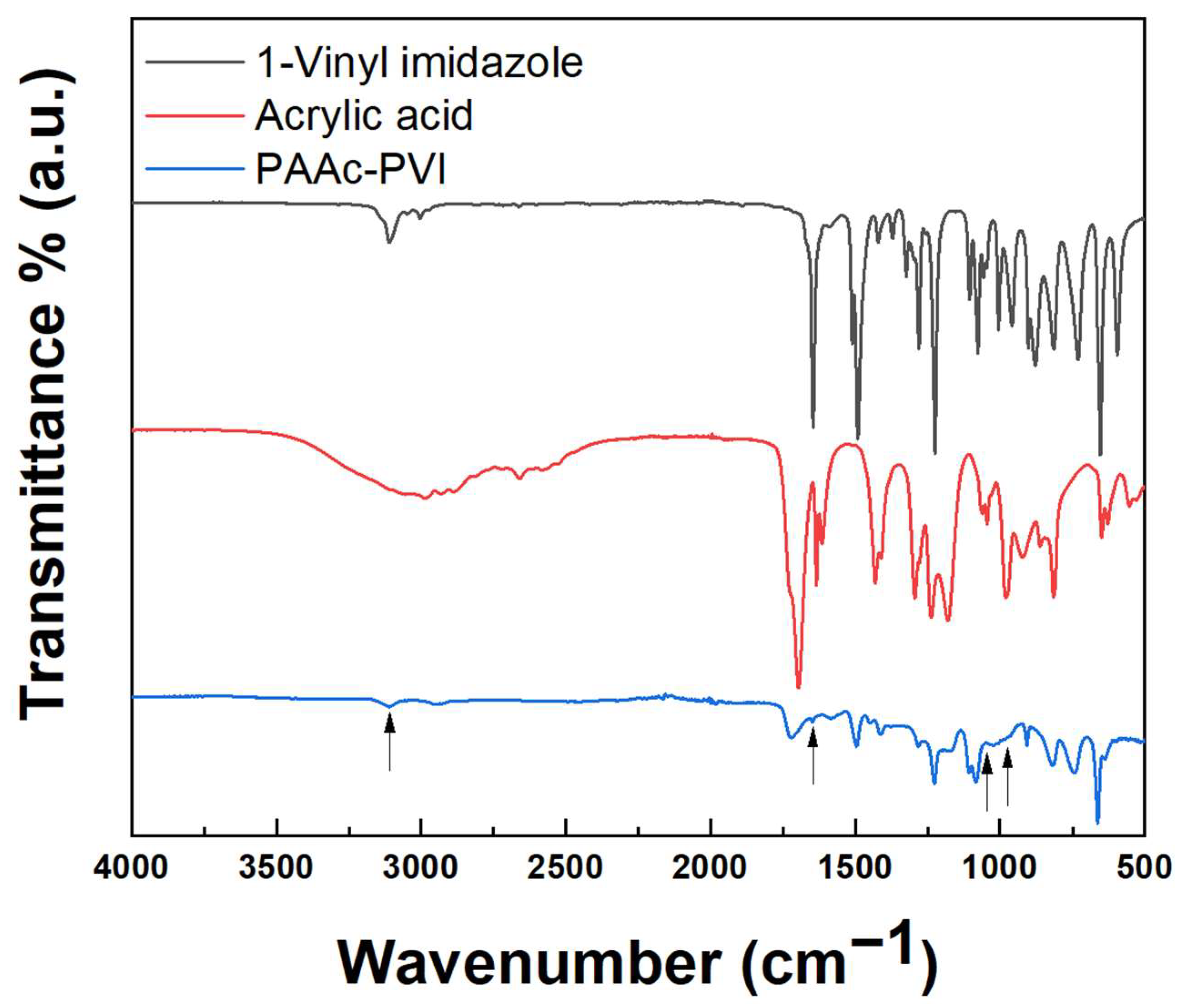
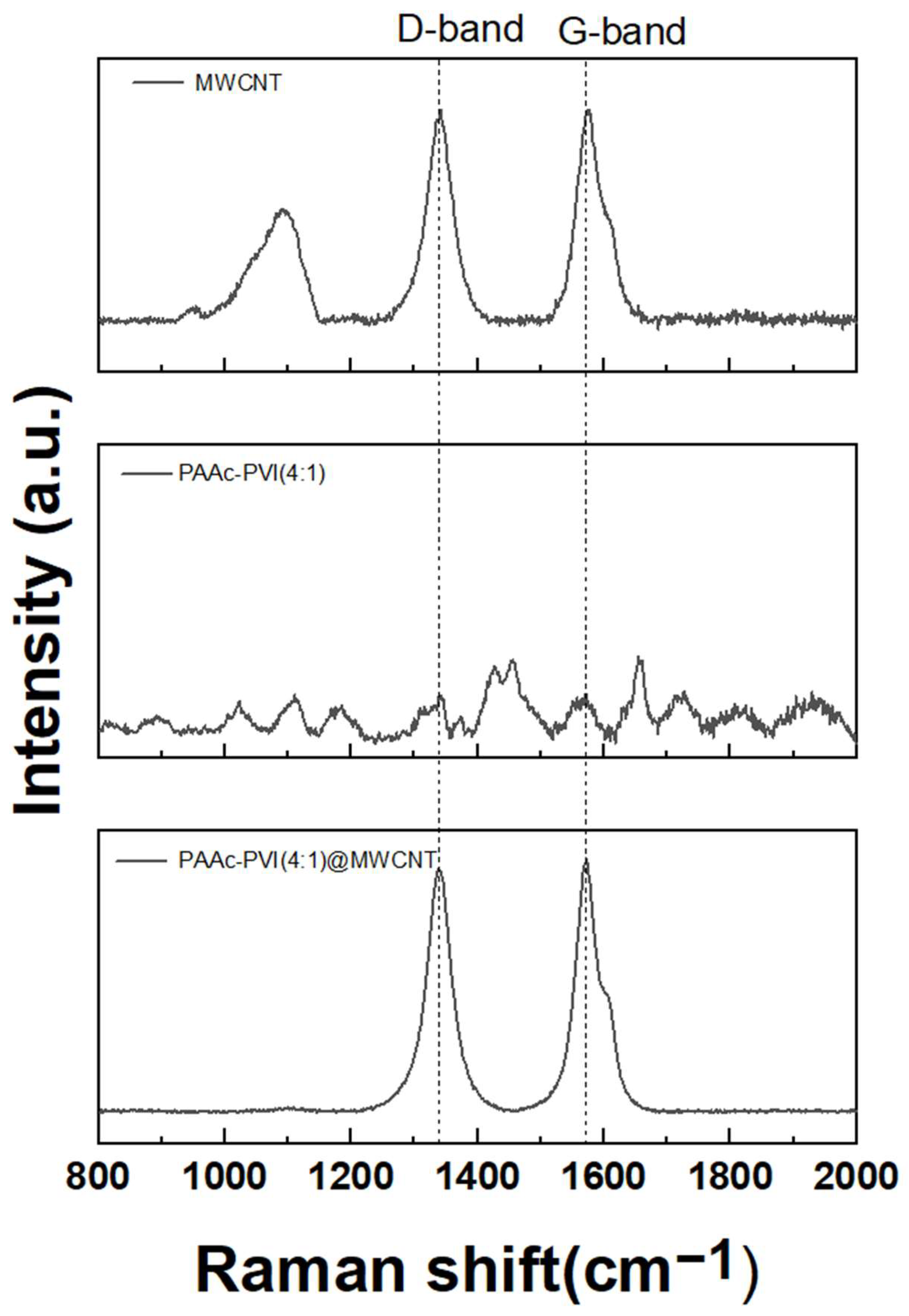
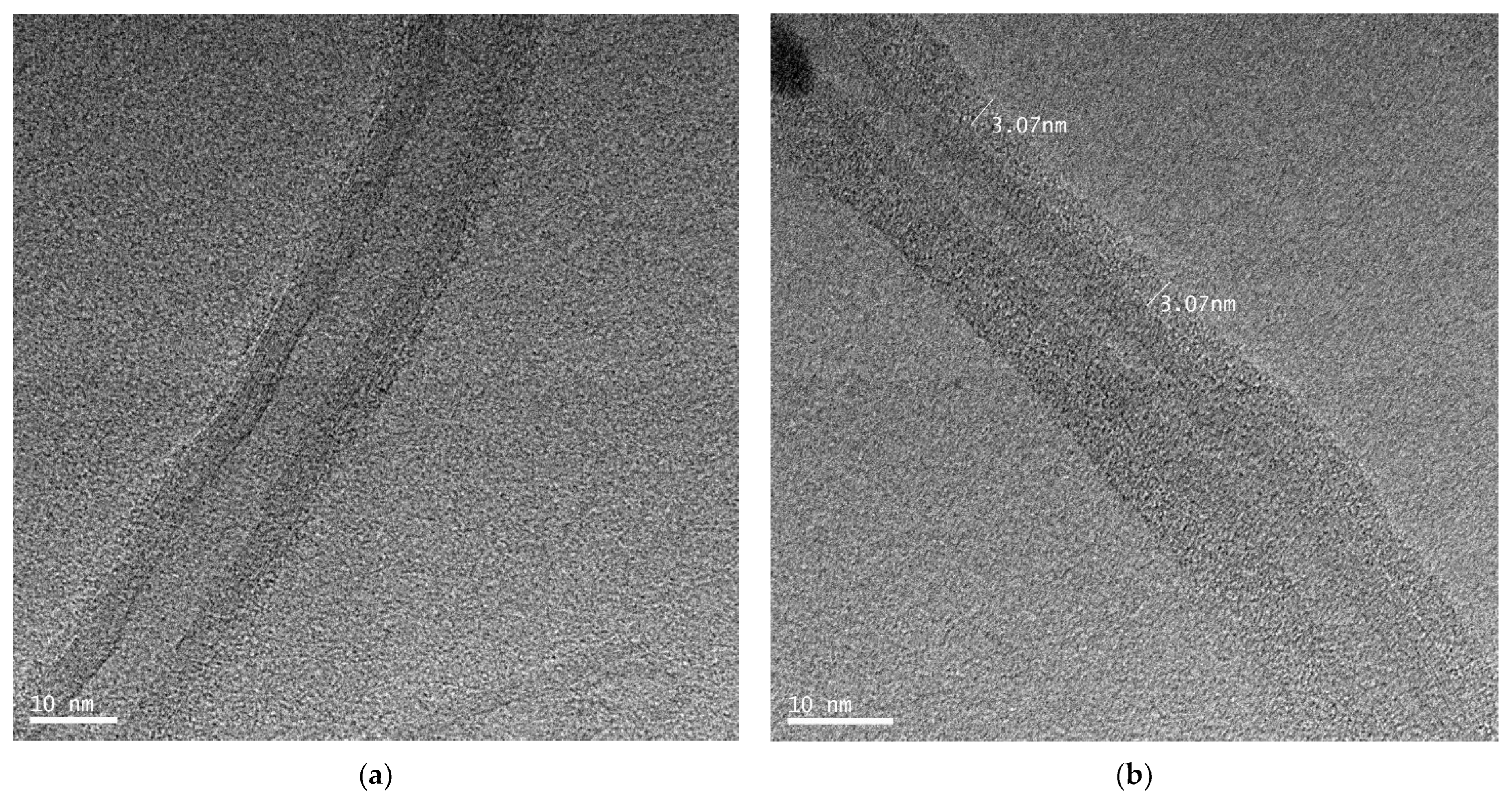

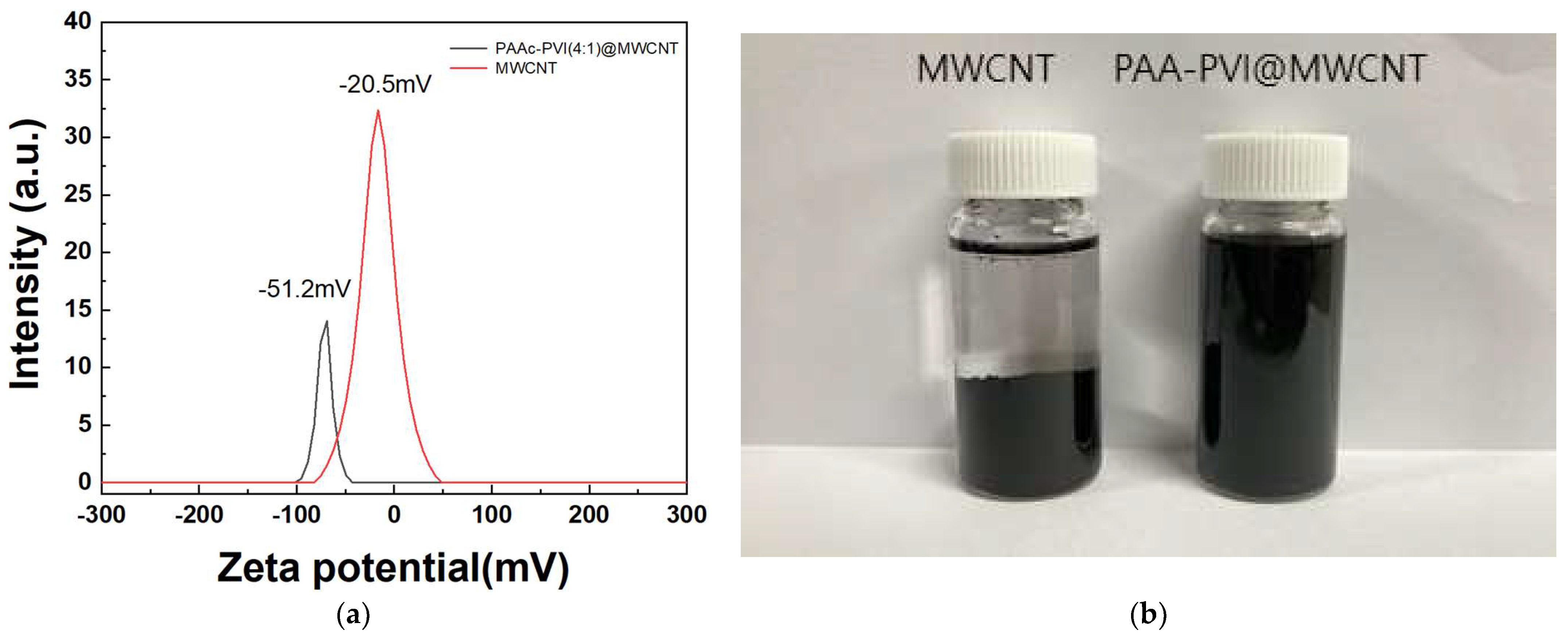
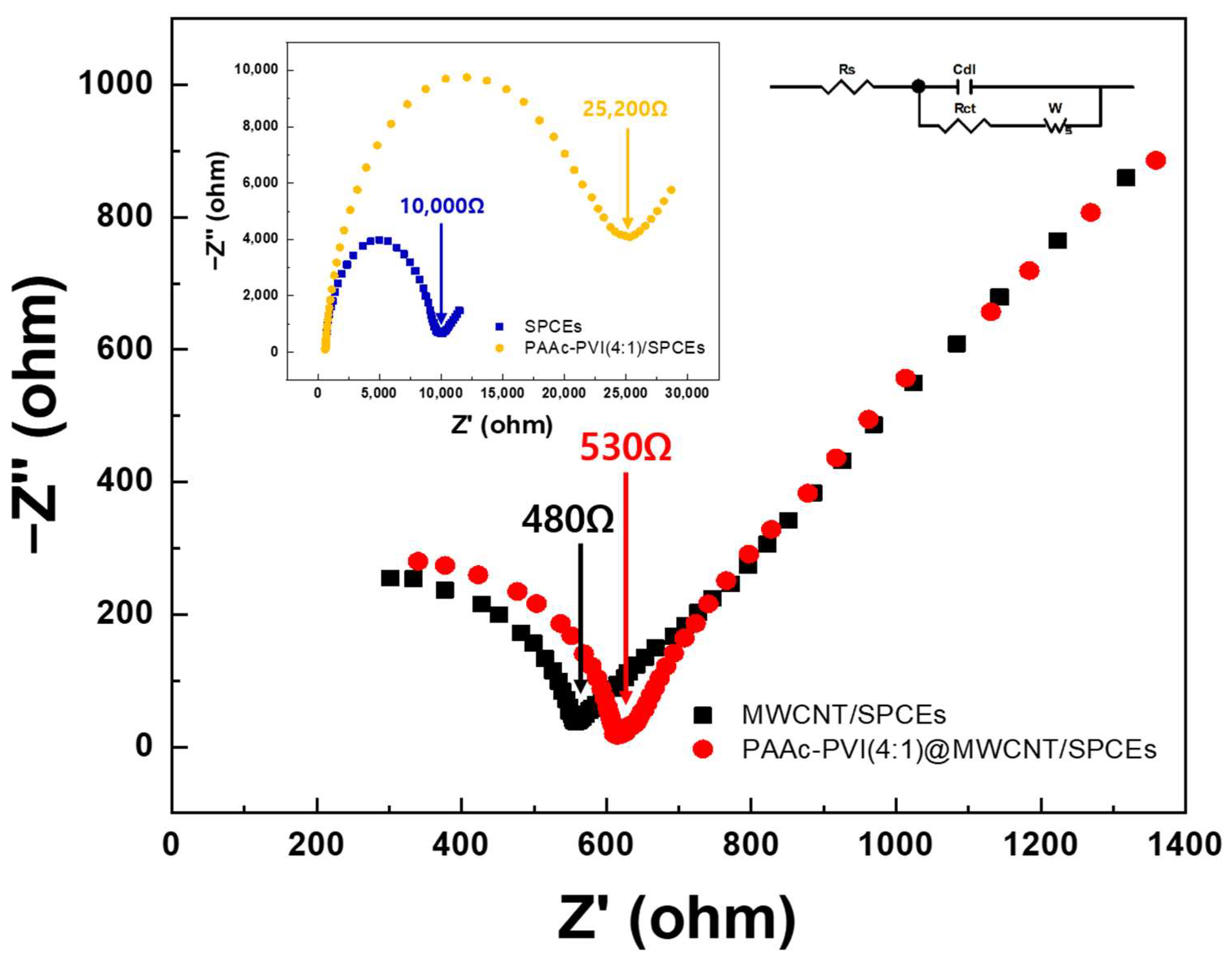
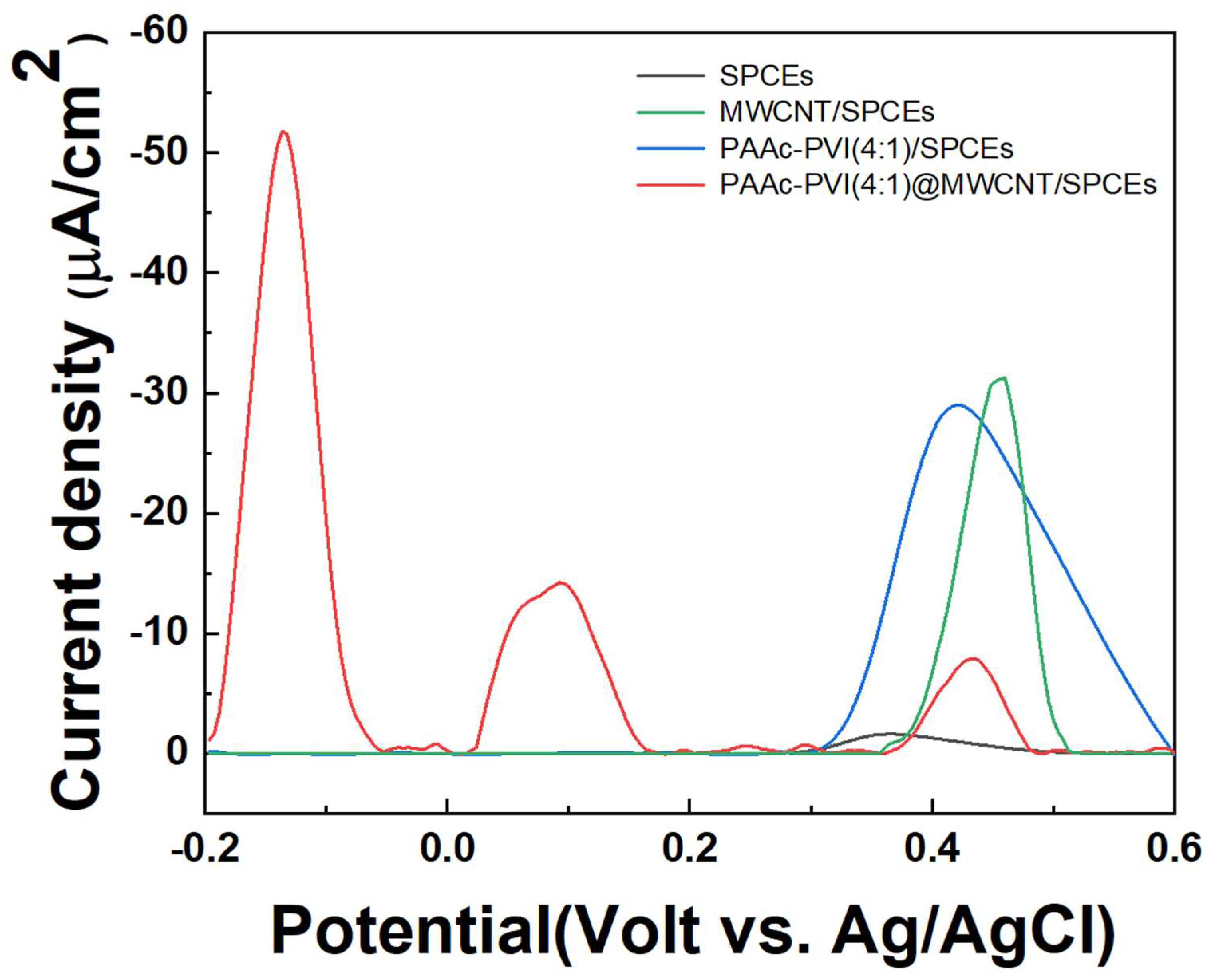
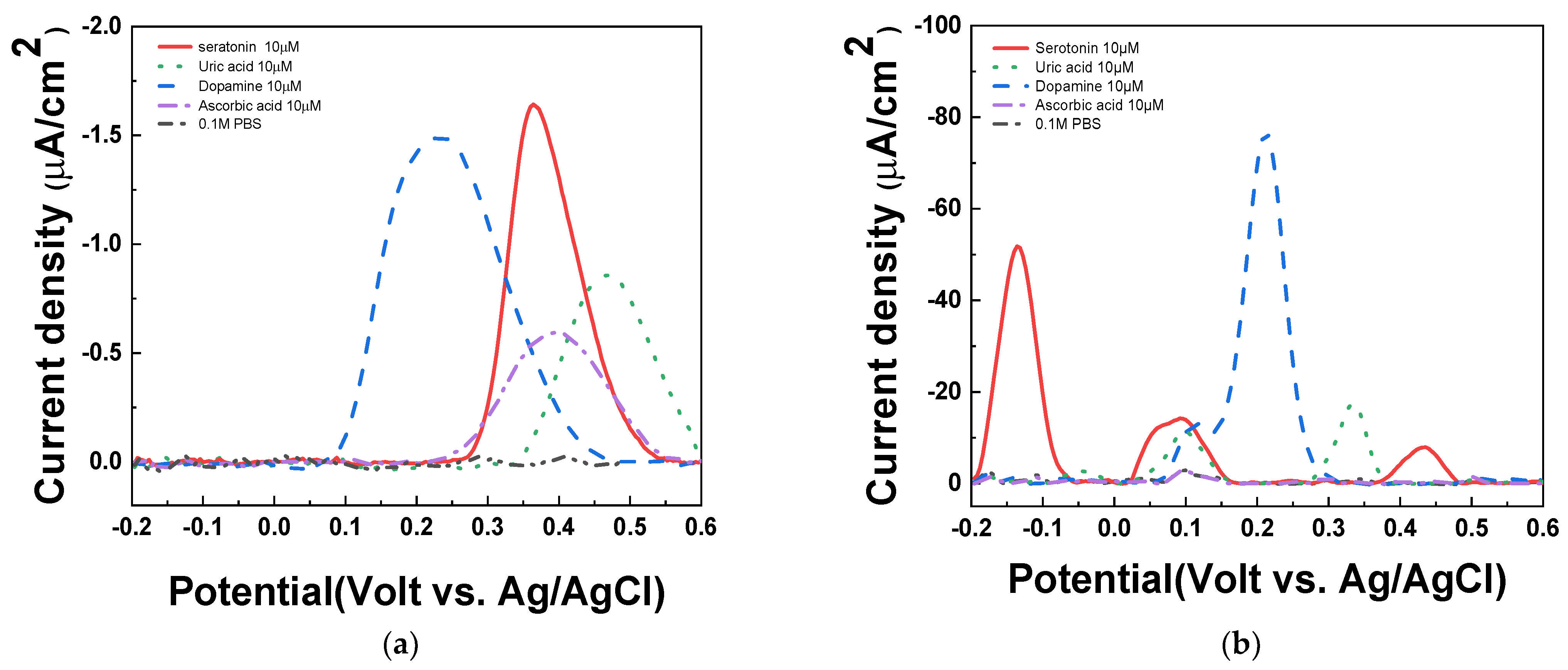
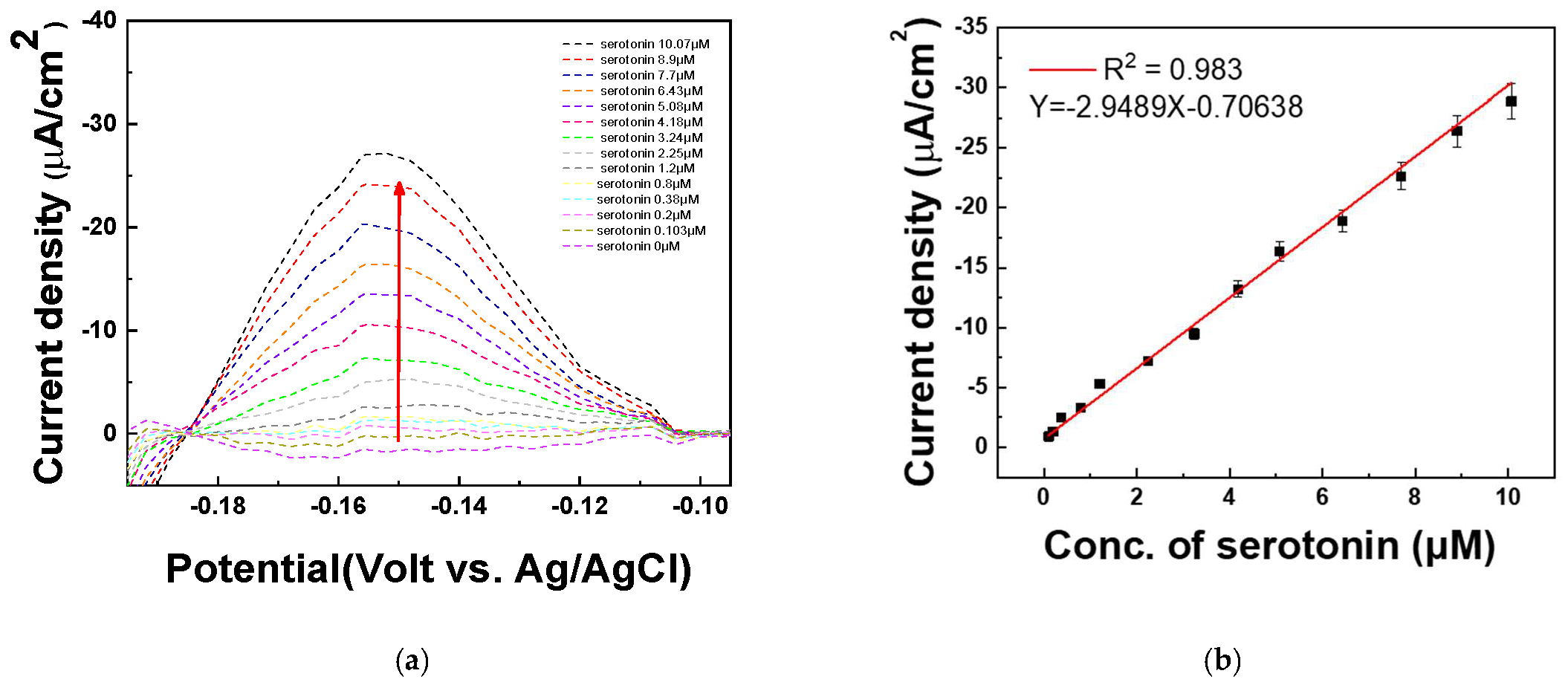
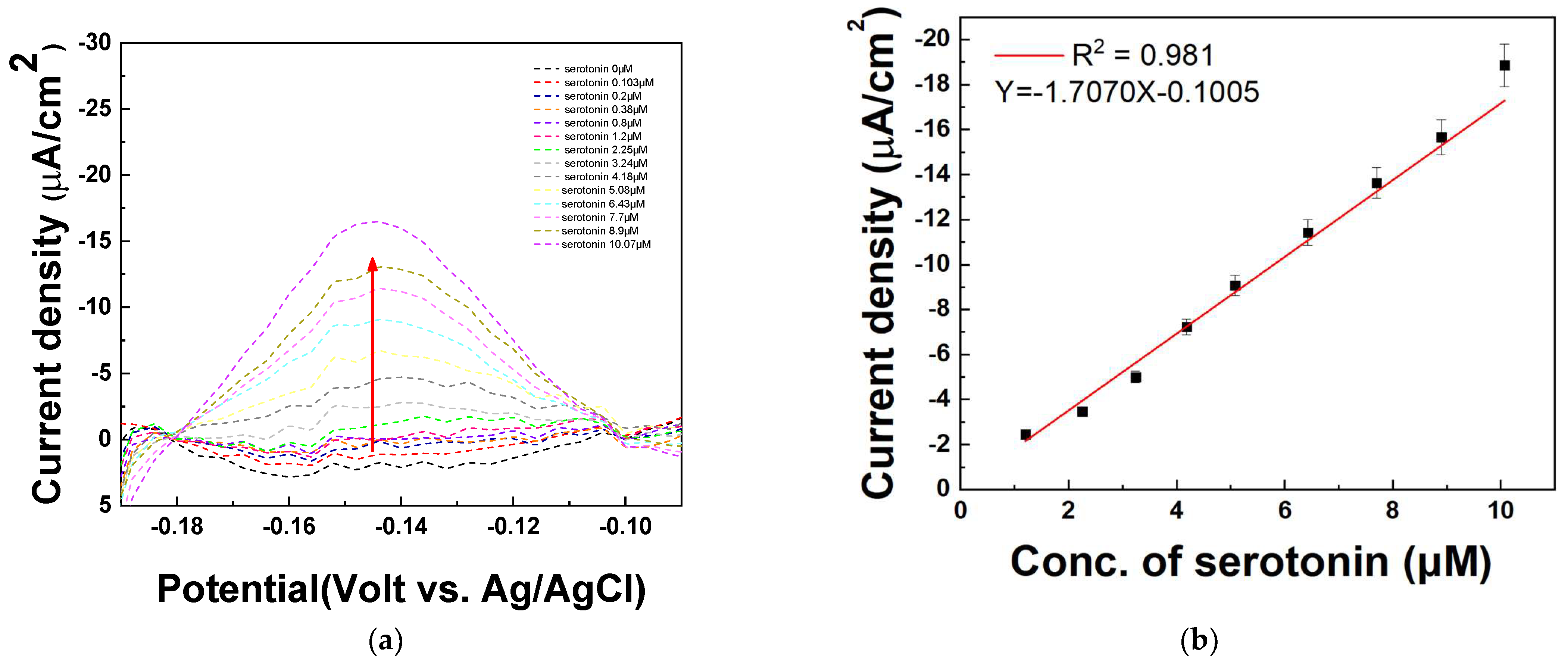
| Intensity of D Band (1350 cm−1) | Intensity of G Band (1583 cm−1) | Ratio (ID/IG) | |
|---|---|---|---|
| MWCNT | 23,264.9 | 23,301.47 | 0.998 |
| PAAc-PVI@MWCNT | 25,288.6 | 27,052.2 | 0.965 |
| RSD% (n = 4) | |||
|---|---|---|---|
| 0 μM | 1.20% | 3.24 μM | 4.12% |
| 0.103 μM | 0.23% | 4.18 μM | 3.79% |
| 0.2 μM | 3.59% | 5.08 μM | 3.95% |
| 0.38 μM | 1.79% | 6.43 μM | 3.43% |
| 0.8 μM | 4.63% | 7.7 μM | 1.42% |
| 1.2 μM | 2.91% | 8.9 μM | 1.39% |
| 2.25 μM | 3.83% | 10.07 μM | 2.88% |
| LOD | LOQ | ||
| 0.015 μM | 0.05 ± 0.025 μM | ||
| RSD% (n = 4) | |||
|---|---|---|---|
| 0 μM | 2.71% | 3.24 μM | 3.87% |
| 0.103 μM | 4.46% | 4.18 μM | 4.29% |
| 0.2 μM | 3.70% | 5.08 μM | 4.81% |
| 0.38 μM | 4.01% | 6.43 μM | 4.17% |
| 0.8 μM | 4.63% | 7.7 μM | 3.82% |
| 1.2 μM | 2.97% | 8.9 μM | 4.17% |
| 2.25 μM | 1.73% | 10.07 μM | 3.08% |
| LOD | LOQ | ||
| 0.077 μM | 0.26 ± 0.059 μM | ||
Disclaimer/Publisher’s Note: The statements, opinions and data contained in all publications are solely those of the individual author(s) and contributor(s) and not of MDPI and/or the editor(s). MDPI and/or the editor(s) disclaim responsibility for any injury to people or property resulting from any ideas, methods, instructions or products referred to in the content. |
© 2025 by the authors. Licensee MDPI, Basel, Switzerland. This article is an open access article distributed under the terms and conditions of the Creative Commons Attribution (CC BY) license (https://creativecommons.org/licenses/by/4.0/).
Share and Cite
Kim, R.-H.; Jeon, W.-Y.; Seo, T.-W.; Choi, Y.-B. Disposable Electrochemical Serotonin Biosensor Based on the Nanocomposite of Carbon Nanotubes. Chemosensors 2025, 13, 185. https://doi.org/10.3390/chemosensors13050185
Kim R-H, Jeon W-Y, Seo T-W, Choi Y-B. Disposable Electrochemical Serotonin Biosensor Based on the Nanocomposite of Carbon Nanotubes. Chemosensors. 2025; 13(5):185. https://doi.org/10.3390/chemosensors13050185
Chicago/Turabian StyleKim, Ryang-Hyeon, Won-Yong Jeon, Tae-Won Seo, and Young-Bong Choi. 2025. "Disposable Electrochemical Serotonin Biosensor Based on the Nanocomposite of Carbon Nanotubes" Chemosensors 13, no. 5: 185. https://doi.org/10.3390/chemosensors13050185
APA StyleKim, R.-H., Jeon, W.-Y., Seo, T.-W., & Choi, Y.-B. (2025). Disposable Electrochemical Serotonin Biosensor Based on the Nanocomposite of Carbon Nanotubes. Chemosensors, 13(5), 185. https://doi.org/10.3390/chemosensors13050185






